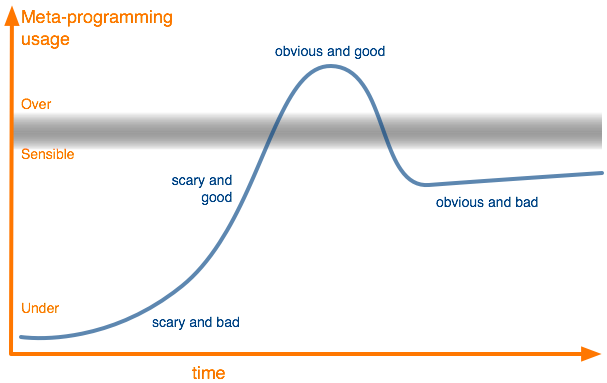Ruby at Thoughtworks
Thoughtworks started using Ruby for production projects in 2006, from then till the end of 2008 we had done 41 ruby projects. In preparation for a talk at QCon I surveyed these projects to examine what lessons we can draw from the experience. I describe our thoughts so far on common questions about Ruby's productivity, speed and maintainability. So far our conclusions are that Ruby is a viable platform that should be seriously considered for many forms of applications - in particular web applications using Ruby on Rails. I also go through some technical lessons, including some thoughts on testing with Active Record.
11 June 2009
If you would rather watch a video of this material, watch my talk from QCon London.
Thoughtworks, my employer, is primarily a software delivery company. We build software for people, including products built for ourselves. An important part of our philosophy is an openness to to different development platforms, so we can choose the appropriate platform for our widely varying clients. When I joined Thoughtworks in 2000, Java was our overwhelmingly major platform. Shortly afterwords we started working with .NET and these two platforms dominated our work by the middle of the decade.
A few people, however, had started experimenting with LAMP scripting languages, in particular Ruby. The appearance of the Ruby on Rails web framework gave Ruby a big push, enough that in 2006, we started doing some serious project work with the Ruby platform. As I write this in 2009, the Ruby platform has a firm share of our work, not as high as Java and C#, but a significant portion.
During these three years we've learned a lot about Ruby in practice. As 2009 began, I was asked to give a talk on our experiences with Ruby for the QCon conference. To prepare for this I conducted an extensive survey of our Ruby projects and probed our Ruby leaders for their thoughts and experiences. It's taken me a bit longer than I'd like to produce this article as well, but here it is.
I've divided the article into three parts. To start with I'll look at the profile of our Ruby project experience, to give you a sense of what kinds of projects we've been tackling over the years. Next I'll move onto several common questions about Ruby and how our experiences answer these questions. Finally I'll launch into some lessons we've learned from using Ruby.
The Shape of Our Projects
During 2006-8, Thoughtworks has been involved in some 41 Ruby projects. I define a Ruby project as a project where Ruby was the primary development language. Ruby has appeared on other projects too, there's a lot of recent developments using ruby for build automation or functional testing for Java projects. Almost all these projects have involved Rails, and most of them are web site projects where Rails is at least as important as Ruby.

Figure 1: Scatterplot of peak headcount versus involved length for Thoughtworks Ruby projects in 2006-8.
Figure 1 gives a feel for the size of the projects we've been involved in. The headcount here is the peak headcount of everyone involved (Thoughtworks, client and others; developers, project managers, analysts etc). The length is the duration that we've been involved in the project.
Ruby projects are generally seen as shorter and smaller than other projects. Sadly I don't have comparative data for our projects on other platforms to get a better feel on whether this is true. Certainly we can see that most projects involve less than 20 people for less than a year.
There are a few projects that stand out. By far our largest project is the one that I'll refer to as the Atlanta project, with a peak headcount of over 40 people involved. Another large and long running project is the Jersey project. These two are related in that there's been a good bit of rotation between the two, so many of our more experienced Ruby people have been on both projects.
The third project I've called out here is Mingle, which is a particularly interesting case as it's a product from Thoughtworks Studios - and as such we can be more public about it than we can about projects done for clients. It's been a long running project and also an international project: starting in Australia, moving to Beijing, and now multi-sited in Beijing and San Francisco.

Figure 2: Strip chart showing effort for project for each year.
Figure 2 looks at the shape a different way, looking at the effort involved in the various projects we've been involved in for each year. Each dot on the strip chart represents total effort (all people) in one project during that year. This chart provides a good feel for how much increase we've seen in ruby projects over the last three years.

Figure 3: Strip chart showing project effort per host country
Figure 3 looks at the projects by host country. It's somewhat rough and ready, as I haven't tried to properly deal with the few multi-site projects or projects that have moved (Mingle, for example, I classed as a China although it's history is more varied.)
The country split shows that the US has seen the biggest interest in Ruby work. India has also seen a fair amount - indeed our first Ruby project was run out of Bangalore. The UK has seen less uptake. This probably reflects the fact that our early Ruby advocates were mostly US based and there was considerable skepticism to Ruby in the UK. The level of involvement from India is encouraging, traditionally India is seen as a laggard in using new technologies but we seem to be doing a reasonable job of making our Indian offices be rather different.
Our experience selling Ruby work is that using a dynamic language like Ruby fits in well with our overall appeal. Our strength is that we hire highly talented people who are difficult to attract to the typical IT organization. Ruby has a philosophy of an environment that gives a talented developer more leverage, rather than trying to protect a less talented developer from errors. An environment like Ruby thus gives our developers more ability to produce their true value.
Ruby also fits in with our preference for using agile software development processes. The agile philosophy is one of rapid feedback by building software and reviewing it regularly with the customer. The more productive an development environment, the more frequently you can review progress, and the better the agile “inspect and adapt” process works.
Questions About Ruby
Was Ruby the Right Choice?
When looking back on our 41 projects, perhaps the most important question to ask is whether the Ruby platform was the correct choice. One way to approach that question is to ask technical leads on the project whether, in hindsight, they think the choice was correct.

Figure 4: Was Ruby the correct choice of platform for this project?
As Figure 4 indicates, the vote was a very positive 36 to 5 support of the choice. As a group our technical leads are usually not shy of indicating if they are unhappy with a technological choice. So I see this as a firm statement of the viability of the Ruby platform as a reasonable choice.
I dug a little more into the five regretful projects. The first thing that stood out was that in four of the five cases, the leads felt that using Ruby wasn't a worse choice than the alternatives. Ruby's relative unusualness means that we feel that using Ruby has to come with a benefit over alternatives, if Ruby is the same as a more widely used option, then it isn't worth introducing the unusual technology. Four of the five also reported problems due to integration with other technologies that Ruby isn't as well suited for. .NET tools tend to integrate better with .NET technologies, for example. Another theme that two of the projects reported was social issues - that people in the client organization were opposed to Ruby or other dynamic languages. The one worse-off project showed these social problems - an IT organization that resisted Ruby tooth and nail (the business sponsor in this case was a Ruby fan).
Indeed when I asked further about red flags for using Ruby in software project, the only clear answer was around social issues. Ruby was generally accepted or encouraged for our software development work, but the biggest sign to avoid it was a social resistance from the client.
Is Ruby More Productive?
When people are asked about why Ruby should be used on a project, the most common answer is for increased productivity. One early indicator was an assessment of a project that suggested that Ruby would have yielded an order of magnitude improvement in productivity.
As a result it seemed obvious to survey the project technical leads and ask them about productivity - had ruby increased productivity and if so, by how much. I asked them to compare this to a mainstream (Java or .NET) project done in the most productive way they knew how.

Figure 5: How much did Ruby improve productivity for this project? (Compared to the best mainstream tools you know.)
You should take these result with some salt. After all there is no way we can objectively measure software productivity. These are just the subjective, qualitative assessments from the technical lead of each project. (I didn't get a response from all projects.) However they are still suggestive that there's a real productivity boost going on.
This suggestion is further reinforced by staffing considerations. Scott Conley, who manages our Atlanta office, reports that once a ruby project has got going, he expects them to need 50% more people whose focus is on requirements preparation than would be expected for other technologies.
One thing we have seen is that you shouldn't expect these productivity increases to turn up right away. I've heard several times that people were alarmed in early weeks about the slow progress of a new Ruby team - a consequence of what I call the Improvement Ravine. It does take time for a Ruby team to get the hang of how the platform works and during that time they'll be slower than you expect.
The improvement ravine is a common phenomenon and a usual palliative is to ensure there are some experienced people on the team. Our history, however, is that the most important experience here is that of dynamic languages that support the kinds of meta-programming features that Ruby does, rather than specifically Ruby experience. As Scott Conley puts it: the difference is between efficiency risk and delivery risk. A team with dynamic language experience but little Ruby experience will be slower initially (efficiency risk) but a team without any dynamic language experience can produce a knotty code base that could risk the overall delivery.
Is Ruby Slow?
In a word “yes”. Search around for benchmarks on the net and you'll find numerous surveys that show that, even by the standards of scripting languages, Ruby is a tortoise.
On the whole, however, this has been irrelevant to us. Most of our uses of Ruby are in building database backed websites. I've visited many projects over the decades like this, using Ruby and other technologies, nearly every project has spent time working on performance issues and in almost every case those performance issues are database access. People spend time tuning SQL not tuning their processing code. So since most applications are I/O bound, the use of a slow language for processing doesn't make any appreciable impact to the overall performance of a system.
You'll notice I've used the usual pundit weasel words in the above paragraph. Although almost every project is I/O bound, you do run into the occasional exception - and an interesting one is Mingle. Mingle is unusual in many ways. It's very dynamic display means it can't use any page caching to improve performance, which immediately makes it unlike most web applications. As a result it isn't I/O bound and for good performance needs more hardware than many people expect (a four core box with 2GB of memory to support a 20-40 person team).
But the Mingle team still feel they made the right choice in using Ruby. The Mingle team has built many features very quickly and they feel the productivity boost they got from Ruby is worth the higher hardware demands on the final product. As with so many things, this is a hardware versus productivity trade-off - one of the oldest trade-offs in computing. Each team needs to think about which matters. The good news here is that Mingle has good horizontal scalability (throw more processors at it and you get proportionally good performance). Hardware scalability is often the most valuable thing you can have in these situations as hardware costs keep declining.
I should re-emphasize. For most projects Ruby's speed has been irrelevant as almost all of them are I/O bound. Mingle is an exception, not the common case.
Is a Ruby Code-base Hard to Understand?
A concern we frequently hear about Ruby is that its dynamic typing, support for meta-programming, and lack of tools makes it liable to leave a code base that's difficult to follow. In general this hasn't turned out to be a issue in practice for us. The story I hear is that the fact that you can write much less code for the same functionality means that it's easier to keep the code clean than it is for mainstream languages.
That said, it's important to remember our context. Thoughtworks developers tend to be far above average in terms of ability and also very keen on highly disciplined approaches, such as Extreme Programming. We place a high value on testing (something that's true of the Ruby community generally) and these tests do much to keep the code base clear. So I can't say whether our experiences will carry over to less able and disciplined developers. (Even the tooling and relative control of other languages doesn't stop us from seeing some pretty horrible code, so it's open to question whether a poor Ruby code base would be that much worse.)
We have seen a common sequence of attitudes to meta-programming.

Figure 6: Progression of feelings about meta-programming
- Scary and Bad: People are wary of meta-programming and don't use it much
- Scary and Good: people begin to see the value of meta-programming but are still uncomfortable with using it.
- Easy and Good: as people get comfortable they begin to use it too much, which can complicate the code-base.
- Easy and Bad: people are wary of meta-programming and realize that it's very useful in small doses.
In the end the analogy I like best for these kinds of techniques is that they are like prescription drugs. They are very valuable in small amounts but you need to ensure that you don't overdose.
As with many things, experience is the great helper here as it can get you through this curve more rapidly. In particularly it's important to expect this adoption curve, particularly the over-usage. When learning something new it's common to over-use it at some stage because without crossing the line it's hard to know where that line is. It can also be useful to try and build a sandbox - a relatively contained area of the code-base for people to overdo the meta-programming in. With a suitable sandbox it's easier to undo the over-usage later on.
Is Ruby a Viable Platform
All of these questions sum up into the key question for us: is Ruby (and Rails) a viable platform for us and our clients. The answer thus far is a resounding “yes”. It offers palpable gains in productivity, allowing us to be more responsive and produce better software, more quickly for our clients. This isn't to say it's the right choice for all situations. Choosing a development platform is never a simple choice, particularly since it usually is more of a social choice than a technological choice. But the headline conclusion is that Ruby is a choice that's worth considering, worthy enough for us to want to keep this tool in our toolkit.
An interesting side question here is the role of other less-common languages. Should we be using Groovy, F#, Python, Smalltalk, and others? I wouldn't be surprised if many of the same trade-offs we see for Ruby are true also for these other languages. I hope we'll see some of these added to our toolkit in the future.
I should also stress that it isn't a case of either/or when it comes to using these languages and the mainstream Java/C# options. I've always advocated that development teams using a language like Java/C# should also use a scripting language for various support tasks. Ruby makes an excellent choice for this, and we are seeing this combination increase on our projects. With the rise of support for these languages on the JVM and CLR, we see more opportunities to intermix different languages with different strengths - an approach Neal Ford refers to as Polyglot Programming.
Some Development Tips
In this last section, I'll run over a grab-bag of lessons we've learned from using Ruby.
Testing with Active Record
Right at the beginning of our use of Ruby, there was a debate on how best to organize testing in the presence of the Active Record database layer in Rails. The basic problem is that most of the time, performance of enterprise applications is dominated by database access. We've found that by using a Test Double we can greatly speed up our tests. Having fast tests is crucial to our test-intensive development process. Kent Beck recommends a basic commit build of under ten minutes. Most of our projects manage this these days, and using a database double is a vital part of achieving it.
The problem with Active Record is that by combining database access code with business logic, it's rather harder to create a database double. The Mingle team's reaction to this was to accept that Rails binds the database tightly and thus run all the commit tests against a real database.
The contrary view was advocated most firmly by the Atlanta and Jersey teams. Ruby has a powerful feature that allows you to redefine methods at run-time. You can use this to take an active record class, and redefine the the database access methods in that class as stubs. The team started the gem unitrecord to help with this.
In the three years, we've not seen a generally accepted victor in this debate. The Mingle team run a couple of thousand tests against a real postgres database in around 8 minutes. (They parallelize the tests to make use of multiple cores.) The Atlanta and Jersey teams consider it valuable that their commit test runs in 2 minutes with stubs versus 8 minutes without. The trade-off is the simplicity of the direct database tests versus the faster commit build of the stubbed tests.
While both teams are broadly happy with their positions in this debate, the use of stubbing has led to another issue for the Atlanta/Jersey teams. As the teams became familiar with using method stubbing, they used it more and more - falling into the inevitable over-usage where unit tests would stub out every method other than the one being tested. The problem here, as often with using doubles, is brittle tests. As you change the behavior of the application, you also have to change lots of doubles that are mimicking the old behavior. This over-usage has led both teams to move away from stubbed unit tests and to use more rails-style functional tests with direct database access.
Active Record Leaks
A common situation that people report is time spent futzing with SQL. Active Record does a good job of hiding much database access from the programmer, but it fails to hide it all - essentially the abstraction leaks. As a result people have to spend a reasonable amount of time working with SQL directly.
This leakiness is a common feature of object/relational mapping frameworks. Pretty much every time I talk to people on a project, they'll say that the O/R mapping framework hides the SQL efficiently about 80-90% of the time, but you do need to spend some time working on SQL in order to get decent performance. So in this respect Active Record is really no different from any other O/R mapper.
Indeed one comment I do hear is that with Active Record, the abstraction breaks cleanly. When chatting with DHH, he's always stressed that he believes that developers who use a relational database should know how to work with SQL. Active Record simplifies the common cases, but once you start getting to more complicated scenarios it expects you use SQL directly.
I don't see the leakiness of the O/R abstraction as a condemnation of these frameworks. The point of these frameworks is to improve productivity by making the easier to do common things. It allows a team to focus its effort on the few cases that really matter. The problem only comes when a team believes the abstraction is water-tight, and puts no effort into working with SQL. It's a common failing, but not a reason to abandon the real advantages of O/R frameworks when they are used correctly.
Long Running Requests
A common problem we've seen is applications that get into a tangle when they take on a task that takes some time to carry out. Done naively this can result in the web request handler going dark for a worryingly long time while it deals with the request.
This is a very common issue with any human interface, and has a common solution - handing off the task to a background process or thread. Anyone who has programmed with a rich-client GUI application will recognize doing something like this. People do get themselves into trouble, however, if this hand-off and communication is done badly.
The route I prefer, and fortunately it seems most ThoughtWorkers agree with, is to use an actor. In this model the web request handler takes any long-running task, wraps it in a command and puts it it onto a queue. The background actor then monitors the queue, taking commands off the queue and executing them, signaling the human-interaction actor when it's done with each one. The queue usually starts as a table in the database, and then may migrate to a real message queue system if required.
As with the leakiness of Active Record, I point this out not because it's a particular problem to Rails applications, we see this in all sorts of applications. It's worth pointing out because it seems too easy for many people using Rails to forget that this kind of thing happens, and thus they need to use this kind of pattern. We have found that Rails makes much of the repetitive part of web application easier and quicker to do - but the more involved stuff remains.
Deployment
Rails applications are easy to build, but sadly have been very awkward to deploy. The common scenario of using a pack of several mongrel web servers is at best rather fiddly to set up. This is something that has stuck out rather starkly due to the contrast with the smoothness of much of the rest of the ruby experience.
The current consensus is that Phusion Passenger makes this whole thing very much simpler and is now the recommended deployment approach with the MRI.
We've been also big fans of using JRuby for deployments. JRuby allows people to use the standard Java Web-App stack, which can make it much easier to deal with in many corporate settings. Mingle has also used this approach to make it easier to install for customers. Indeed the Mingle team does all its development with the MRI but deploys to JRuby. They do this because the faster startup time of the MRI makes it quicker to develop on. (JRuby requires a JVM start-up, which is noticeably hesitant.)
Controlling Gems
Ruby includes a package-management system, Ruby Gems, that makes it easy to install and upgrade third-party libraries. Rails also has plugins that carry out a similar task for rails. These are good tools, but it's easy for teams to get in a tangle if different machines are set up with different versions of different libraries.
There's a couple of ways to handle this. The first approach involves taking a copy of the source code for all third-party libraries and checking that into source control. This way a simple checkout will get you all the right version of all the libraries. A second approach is to use a script that downloads and activates the correct versions of all libraries. This script needs to be kept in source control.
Along similar lines, most teams also takes a copy of the Rails source itself. This allows them to apply patches to Rails directly to fix any bugs or other vital issues. These patches can then be sent to the core team. Using distributed version control systems, like git, have made this a good bit easier to manage. It's certainly much easier than our memories of having to decompile and patch Java application servers in the past.
Schedule Time for Updates
Ruby generally, and Rails in particular, moves quickly. There are frequent updates to the rails system, with features that we want to use. We've found that we need to ensure we schedule time for handling rails updates and include these in the planning process. They are more significant than for other platforms, but the good news is that there's a steady stream of new capabilities.
Developing on Windows
Ruby was born in the unix world, and most of the people who have flocked to the platform use forward slashes for directory paths. It is possible to run, deploy, and develop for ruby on a windows platform, but it's also much more tricky. Our general advice is to use a unix platform for all development. Macs are commonly preferred, but plenty of people use other FOSS Unixen too.
We hope this situation will change as Iron Ruby develops. It would be nice to have the option to deploy Ruby applications on the base Unix, JVM, or the CLR. Indeed this would make Ruby a particularly flexible option for runtime support across multiple platforms. It would also help our .NET projects to have Ruby as a scripting language in conjunction with the mainline .NET languages.
Acknowledgments
Even more than usual, I couldn't have put all this together without the collaboration of many of my colleagues. Although I've been using Ruby for much personal work for many years, there's a big difference between one man cobbing together his personal web site and the kinds of application that we do with our clients. I'm grateful that so many of my colleagues took time out to give me the information I needed to truly assess Ruby's value.
And like any users of Ruby, we owe thanks to the wider Ruby and Rails communities. With any open-source effort, the role of the community is vital, so to all Ruby-hackers and Rubyists we at Thoughtworks say ありがとうございました.
Significant Revisions
11 June 2009: First published on martinfowler.com
03 June 2009: Draft for internal TW review

